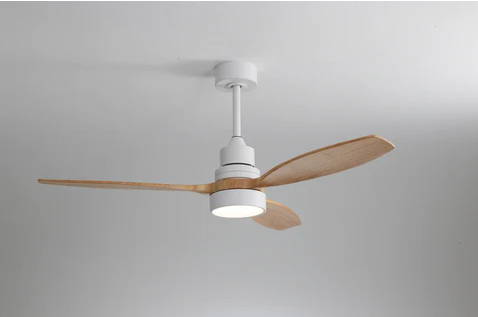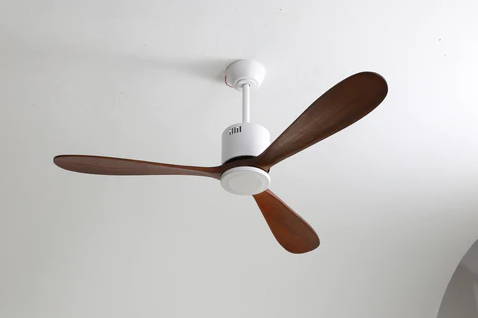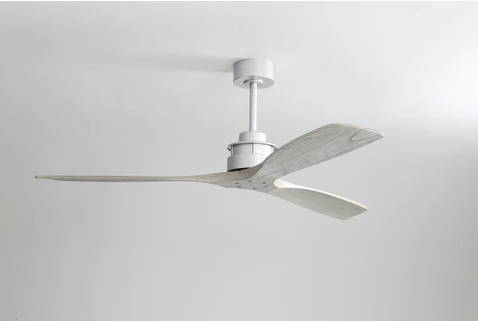
Choosing the Right Ceiling Fan Size for Your Room

Choosing the Right Ceiling Fan Size for Your Room
May 22,2023
Share:
When it comes to selecting a ceiling fan, size matters. Choosing the right sizefan for your room is essential for both efficient airflow and aesthetic appeal.A fan that is too small may not circulate enough air, while a fan that is toolarge can overpower the space. In this comprehensive guide, we will delve intothe factors to consider when determining the ideal ceiling fan size for yourroom. From room dimensions and ceiling height to blade span and motor power,we'll explore the key elements that impact the fan's performance and visualharmony. By the end of this article, you'll be equipped with the knowledge tomake an informed decision and ensure optimal comfort and style in your space.
Subscribe
To join our mailing list and never miss a baby update!
-
Assessing Room Dimensions
The size of your room plays a crucial role in determining the appropriateceiling fan size. This section will discuss how to measure the square footage ofyour room and understand the concept of airflow efficiency. We'll provideguidelines for small, medium, and large rooms to help you determine the generalfan size range required for each category.
-
Qian
-
"After 250 hours of research and testing, including interviewing five baby wearing experts and walking over 100 miles in 15 wraps, slings, and meh dais, we think that the Gemlak Baby Carriers is the best"
Lily
Measure the Length and Width
Use a measuring tape to measure the length andwidth of the room. Measure from wall to wall, ensuring accuracy in yourmeasurements. Round off the measurements to the nearest foot or inch.
Calculate the Square Footage
Once you have the length and widthmeasurements, multiply them together to calculate the square footage of theroom. For example, if your room measures 12 feet by 15 feet, the square footagewould be 180 square feet (12 ft x 15 ft = 180 sq ft).
Identify the Room Size Category
Different room sizes require different fansizes to ensure efficient airflow. Here's a general guideline to categorize roomsizes:
Small Rooms: Up to 100 square feet
Medium Rooms: 100 to 300 square feet
Large Rooms: 300 to 500 square feet
Determine the Fan Size Range
Based on the room size category, you candetermine the appropriate fan size range. The fan size is typically measured bythe blade span, which refers to the diameter of the circle formed by therotating fan blades.
Small Rooms: For rooms up to 100 square feet, consider ceiling fans with ablade span of 36 inches or smaller.
Medium Rooms: For rooms between 100 and 300 square feet, opt for ceiling fanswith a blade span ranging from 44 to 52 inches.
Large Rooms: For rooms between 300 and 500 square feet, choose ceiling fanswith a blade span of 54 inches or larger.
Consider Multiple Fans for Larger Rooms
In larger rooms, it may bebeneficial to install multiple ceiling fans to ensure adequate airflowthroughout the space. Divide the room into sections and determine theappropriate fan size for each section based on its square footage.
Account for Open Concept Spaces
In open concept spaces where multiple roomsflow into one another without walls, consider the total combined square footageof the area when selecting ceiling fan sizes. Take into account the largestcontinuous space to determine the appropriate fan size range.
Keep in mind that these guidelines provide a general starting point forselecting the right ceiling fan size based on room dimensions. However, otherfactors such as ceiling height, the presence of windows or airflow obstructions,and personal preferences should also be considered. Consulting themanufacturer's recommendations for specific fan models is always a good practiceto ensure optimal performance and airflow in your room.
Most Popular
May 23,2023
Trending Articles

Ceiling fan light not working
Considering Ceiling Height
When it comes to choosing and installing a ceiling fan, considering theheight of your ceiling is an important factor to ensure optimal performance andfunctionality. The height of your ceiling will impact the effectiveness of thefan's airflow, the installation process, and the overall aesthetic appeal. Let'sexplore why ceiling height matters and how to choose the right fan for yourspecific ceiling height.
For rooms with standard-height ceilings (typically around 8 to 9 feet), mostceiling fans on the market are suitable. Standard ceiling heights allow for easyinstallation and maintenance. Ensure that the fan blades have sufficientclearance from the floor and other objects in the room. Generally, a minimumclearance of 7 feet is recommended for safety and efficient airflow.
In spaces with high ceilings, special considerations need to be taken intoaccount. High ceilings, often found in grand living areas or commercial spaces,require fans specifically designed for such heights. These fans are typicallyequipped with longer downrods to lower the fan closer to the living area forimproved air circulation. Consider fans with downrods of appropriate length toensure optimal performance.
Vaulted ceilings, characterized by their angled or sloped design, pose uniquechallenges for ceiling fan installation. In such cases, it's crucial to selectfans specifically designed for vaulted ceilings. These fans feature specialmounting brackets and adjustable angles to accommodate the slope. Ensure thatthe fan is securely mounted to the ceiling, allowing for smooth and efficientoperation.
When considering ceiling height, also take into account the room's size andlayout. In larger rooms or open spaces, multiple fans may be required toeffectively distribute airflow. This is especially important for high or vaultedceilings, as air tends to stagnate in these areas.
In conclusion, considering ceiling height is essential when selecting andinstalling a ceiling fan. Standard-height ceilings generally offer moreflexibility, while high and vaulted ceilings require specific fan designs toensure proper functionality and airflow. Take into account the room's size,layout, and clearance requirements to choose the right fan for your space. Byconsidering these factors, you can enjoy the benefits of a well-suited ceilingfan, including improved comfort and energy efficiency.
Understanding Blade Span
Understanding the span of blades is crucial when it comes to selecting theperfect ceiling fan for your space. The span of blades refers to the diameter orsize of the fan's blade sweep, and it plays a significant role in determiningthe fan's performance and effectiveness in circulating air.
When considering the span of blades, it's essential to assess the size of theroom where the fan will be installed. A larger room typically requires a fanwith a wider span to ensure optimal air movement and sufficient cooling orventilation. On the other hand, a smaller room may benefit from a fan with anarrower span to avoid overpowering the space with excessive airflow.
The span of blades also affects the fan's aesthetic appeal. It can contributeto the overall visual balance and proportion of the room. For example, a roomwith high ceilings or spacious dimensions might benefit from a fan with longerblades, creating a sense of grandeur and elegance. Conversely, a room with lowerceilings or limited space may require a fan with shorter blades to maintain aharmonious and unobtrusive presence.
Additionally, the span of blades can influence the noise level generated bythe fan. Fans with longer blades generally move more air but may produce moreaudible sounds compared to those with shorter blades. Therefore, striking abalance between the desired airflow and noise level is essential, ensuring acomfortable and peaceful environment.
In conclusion, understanding the span of blades is essential for selectingthe right ceiling fan that suits both the functional and aesthetic requirementsof your space. By considering factors such as room size, ceiling height, anddesired airflow, you can make an informed decision that enhances both thecomfort and beauty of your living or working area.
Harmonizing Style and Function of ceiling fan
Harmonizing style and function is a key consideration when choosing a ceilingfan for your space, ensuring that it not only enhances the aesthetics but alsoprovides optimal comfort and airflow.
A ceiling fan serves as both a practical appliance and a design element, andfinding the right balance between style and function is essential. The fanshould seamlessly blend with the overall décor and theme of the room, whetherit's a modern, rustic, or traditional style. From sleek and contemporary designsto vintage-inspired options, there is a wide variety of ceiling fans availableto complement any interior design scheme.
Beyond aesthetics, the functionality of the fan should not be overlooked.Consider factors such as the fan's size, blade material, motor power, andefficiency. The fan should be appropriately sized for the room to ensureeffective air circulation. Blade materials like wood, metal, or composite canadd a touch of elegance or durability. A powerful motor will ensure consistentand efficient airflow, while energy-efficient models can help save onelectricity bills.
By selecting a ceiling fan that harmonizes style and function, you create acohesive and visually pleasing environment while enjoying the cooling benefits.It becomes a statement piece that not only adds character to the room but alsoserves as a reliable and practical solution to improve air circulation, regulatetemperature, and create a comfortable atmosphere for you and your visitors.
Remember, the right ceiling fan can be a striking centerpiece that enhancesthe overall appeal of your space while providing a refreshing breeze during hotsummer days or circulating warm air during colder seasons.
Conclusion
Selecting the right ceiling fan size for your room involves carefulconsideration of room dimensions, ceiling height, blade span, and motor power.By understanding these factors and their impact on airflow and aesthetics, youcan make an informed decision that combines both comfort and style. Remember toassess the unique requirements of your space and consult manufacturers'recommendations for specific fan models. With the guidance provided in thiscomprehensive guide, you'll be well-equipped to choose a ceiling fan.
Measure the Length and Width: Use a measuring tape to measure the length andwidth of the room. Measure from wall to wall, ensuring accuracy in yourmeasurements. Round off the measurements to the nearest foot or inch.



